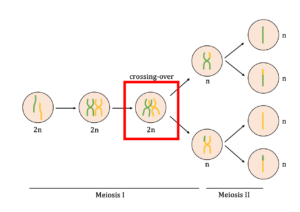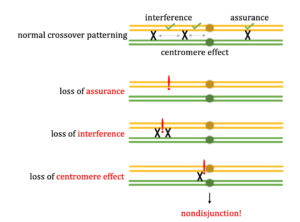When most cells in our body divide, they first replicate their genetic material (as well as everything else) to ensure that the two daughter cells formed have the same amount of DNA and the same number of chromosomes. This form of cell division is known as mitosis and happens in every cell in our body with two notable exceptions: the sperm and the egg – cells that give rise to our gametes. When parent cells of the sperm and the egg divide, they do so through a process known as meiosis. Meiosis differs from mitosis most obviously in the fact that chromosome number in daughter cells is halved. This is because the primary function of sperm and egg cells is to fuse together to produce the zygote, which eventually develops into a whole organism. If both the sperm and the egg had the same number of chromosomes as every other cell in our body, the fused product would have twice the number of chromosomes as it should, resulting in the formation of an inviable zygote.
To ensure that chromosome number is halved, maternal and paternal homologous chromosomes have to segregate from one another during meiosis. This in turn requires a reciprocal exchange of chromosome arms between homologs in a process known as meiotic recombination (or meiotic crossing-over). Crossing-over creates a physical link between maternal and paternal homologs, creating a tension between them when they are pulled to opposite sides of the cell, that helps to ensure that they are paired correctly. This process, while widely thought to be important solely for the genetic diversity it creates, is essential to promote the accurate segregation of homologous chromosomes. Thus, meiotic recombination is crucial to prevent a situation where daughter cells end up with an incorrect number of chromosomes; a condition known as aneuploidy, that can be responsible for miscarriages and chromosomal disorders.

An interesting fact, however, is that it is not simply the presence of crossovers but also their placement along the chromosome that helps prevent aneuploidy. Although the double strand breaks (DSBs) that initiate crossover formation may be distributed somewhat randomly along a chromosome, crossover placement is highly regulated, and this regulation is known as crossover patterning. Over the past century, different patterning events have been identified: 1. crossover assurance, which ensures the presence of a crossover between every pair of homologs, 2. crossover interference, which ensures that two crossovers do not form immediately adjacent to one another, and 3. crossover suppression, which facilitates the exclusion of crossovers in certain regions of the chromosome such as in regions surrounding the centromere and the telomere.

Although we have known of these patterning phenomena for nearly a century now, their mechanisms of action still remain poorly understood and are an active area of research in many labs, including ours – the Sekelsky lab. Interestingly, some patterning events are more popular areas of study than others; for instance, over the course of the last century, many different models have been suggested to explain how crossover interference manifests in meiotic cells. However, it is important to note that a consensus is yet to be reached.
The mechanisms behind assurance and the centromere effect are also still a mystery. Furthermore, since different labs study these events in different model organisms, it is possible that what is true in one organism isn’t representative of what happens in the rest. So if you are interested in figuring out the nifty ways in which meiotic cells prevent segregation errors by regulating the placement of crossovers along a chromosome, you’ll be happy to know that there is still much to be done!
Peer editor: Fanting Kung